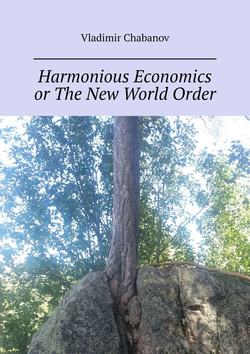Harmonious Economics or The New World Order. 2nd edition by supplemented

Реклама. ООО «ЛитРес», ИНН: 7719571260.
Оглавление
Владимир Чабанов. Harmonious Economics or The New World Order. 2nd edition by supplemented
Introduction1
I. GENERAL THEORY OF HARMONIOUS ECONOMY
CHAPTER 1. ECONOMICS AS A SCIENCE
§1.1. CULTURE AND ECONOMICS
1.1.1. Place of economics in the world knowledge system
1.1.2. Differences between western and eastern cultures and their influence on the economic structure
1.1.3. Russia and Europe, collision civilisations
§1.2. ECONOMIC OBJECTIVES AND TOOLS
1.2.1. What is economics?
1.2.2. Fundamental purpose of harmonious economics
1.2.3. Human needs, commodities and production means
§1.3. SOCIAL LABOUR PRODUCTIVITY AND ITS CONSTITUENT FACTORS
1.3.1. Structures of modern economics
1.3.2. Social labour productivity (SLP) as key indicator of state functioning
1.3.3. SLP suppressing factors
1.3.4. Productive economic factors
1.3.5. Labour differentiation and cooperation
CHAPCHAPTER 2. ECONOMIC SYSTEMS AND THEIR PECULIARITIES
§2.1. MARKET AND ADMINISTRATIVE CONNECTIONS WITHIN ECONOMIC STRUCTURES
2.1.1. Advantages and disadvantages of market connections
2.1.2. Power and administration
2.1.3. Comparison of the market and the administrative regulators qualities
§2.2. ECONOMIC SYSTEMS AND THEIR FEATURES
2.2.1. Characteristic features of various politico-economic entities and their potential
2.2.2. Analysis of capitalist system
2.2.3. Socialist system tupical features
2.2.4. How the USSR was destroyed
2.2.5. Properties and productive capacities of Neo-colonial countries
2.2.6. Harmonious form of social organization
§2.3. GENERAL THEORY OF ECONOMIC SYSTEMS
2.3.1. Economic systems and their properties
2.3.2 Principles of functioning of economic systems
2.3.3. Connections within highly organised systems
2.3.4. Special features of formation of highly organised economic systems
II. SYSYEM-FORMING MEASURES FOR HARMONIOUS ECONOMY
CHAPTER 3. LABOUR AND MONEY, THEIR UNITY AND INDISSOLUBLE CONNECTION
§3.1. LABOUR AND ITS CHARACTERISTICS
3.1.1. How can human labour be measured?
3.1.2. Social labour intensity of commodities (SLIC) as key parameter of enterprise work
3.1.3. Value and value-forming factors in harmonious economics
§3.2. MONEY AND ITS TRANSFORMATION IN MODERN GLOBAL CONDITIONS
3.2.1. Money, its evolution and form
3.2.2. Fundamental drawbacks of modern money
§3.3. PRINCIPLES OF FORMATION OF A HIGHLY ORGANISED FINANCIAL SYSTEM
3.3.1. Labour and money
3.3.2. Velocity of money circulation and its dependence on the state of economy
3.3.3. Founding of a reliable financial system
3.3.4. Setting up an equal foreign trade of states, and the result of implementation of the new financial system
3.3.5. Price structure and its influence on economy
CHAPTER 4. HARMONISATION OF ECONOMIC ACTIVITIES OF ENTERPRISES AND REGIONS
§4.1. LABOUR REMUNERATION AND ITS ECONOMIC IMPACT
4.1.1. Requirements for effective labour remuneration. Pareto principle
4.1.2. Difficulties of adopting a harmonious from of labour remuneration
§4.2. ORGANISATION OF THE COLLECTIVE CONSUMPTION SYSTEM
4.2.1. Taxes as a tool for financing of collective and social needs of the population
4.2.2. Principles of formation of a harmonious tax system
§4.3. ORGANISATION OF ADMINISTRATIVE GOVERNANCE SYSTEM
4.3.1. General recommendations on organisation of efficient administrative governance
4.3.2. Nature of administrative governance in a harmoniously organized
4.3.3. Funds economic management mechanisms
CHAPTER 5. PROGRAM FOR CREATION OF A HARMONIOUS AND SUCCESSFUL TERRITORY (LADZEMLYA)
§5.1. PROGRAM SUBJECT AND METHODS
5.1.1. Ladzemlya: founding principles
5.1.2. Measures required for creation of a Ladzemlta
§5.2. DESCRIPTION OF SPECIFIC PROGRAM MEASURES
5.2.1. Auxiliary measures and control of their implementation
5.2.2. Assessment of socio-economic consequences of implementation the Ladzemlya program
CONCLUSION
REFERENCES
Отрывок из книги
The book offers a profound analysis of economy aimed at providing better living conditions to the population rather than allowing individuals to get more profit. The research studies the existing political and economic structures, discovering their advantages and drawbacks. It shows that a harmonious economy that reconciles the interests of all people and states, of Nature and Humanity, and valorises order and justice, is the most efficient. The methods of building financial, tax, and administrative systems, as well as production relations, within such structures are described, too. The deep analysis, the concise and logical style, and the opportunities offered make this original book unparalleled. The implementation of this theory will resolve many issues of modern economy, as well as improve the quality of life of people.
Created with Ridero smart publishing system
.....
The governance within such system turned out to be overcentralized, as the result, the ruling elites acquired all-embracing power. The worker became just a cog in the production machine, well cared for (the Soviet social security system is still unrivalled), but deprived of all rights. And this lack of harmony eventually conditioned the collapse of the socialist system.
Resuming what has been said above, it is possible to conclude that neither the capitalist, nor the socialist economic models is perfect. Neither of the two has reconciled labour differentiation and cooperation, the private and the common, the functioning of the active and the passive social forces. Therefore, the economic success of both capitalist and socialist countries was less impressive than it could have been provided the current scientific, technological and human intellectual development.
.....